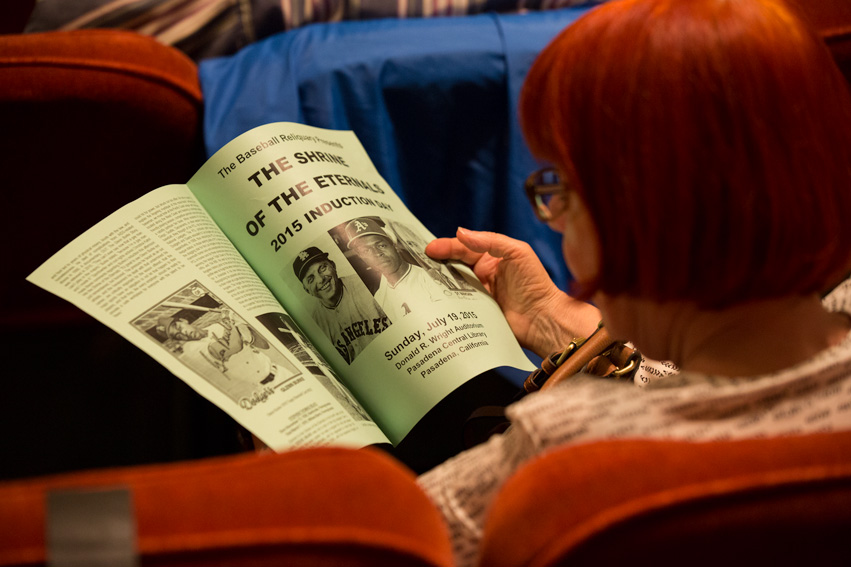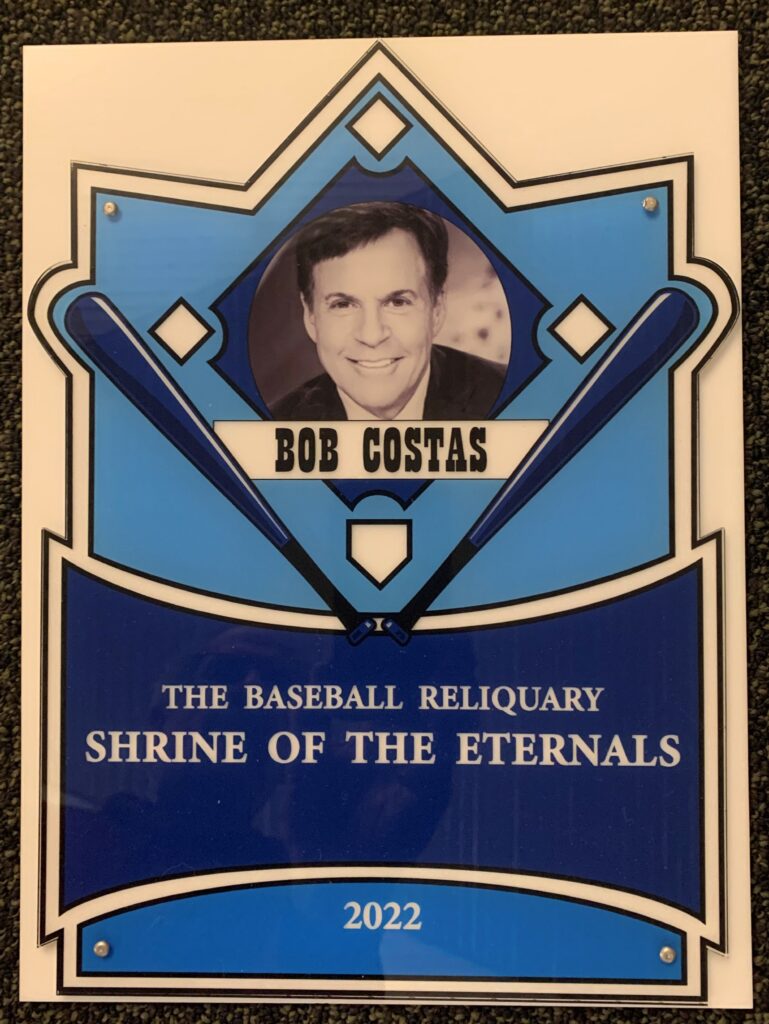The Baseball Reliquary Announces
2009 Class of Electees to
the Shrine of the Eternals
The Board of Directors of the Baseball Reliquary, Inc., a Southern California-based nonprofit organization dedicated to fostering an appreciation of American art and culture through the context of baseball history, is pleased to announce the 2009 class of electees to the Shrine of the Eternals. The Shrine of the Eternals is the national organization’s equivalent to the Baseball Hall of Fame.
Steve Dalkowski, Roger Maris, and Jim Eisenreich were elected upon receiving the highest number of votes in balloting conducted in the months of April and May 2009 by the membership of the Baseball Reliquary. The three electees will be formally inducted into the Shrine of the Eternals in a public ceremony on Sunday, July 19, 2009 at the Pasadena Central Library, Pasadena, California.
Of the fifty eligible candidates on the 2009 ballot, Steve Dalkowski received the highest voting percentage, being named on 34% of the ballots returned. Following Dalkowski were Roger Maris with 30% and Jim Eisenreich with 27%. Runners-up in this year’s election included Effa Manley (26%), Casey Stengel (26%), Don Zimmer (26%), Charles M. Conlon (23%), Dizzy Dean (22%), and Luis Tiant (22%).
Steve Dalkowski
The inspiration for wild fastball pitcher Nuke LaLoosh in the movie Bull Durham, STEVE DALKOWSKI etched his name in baseball lore during nine highly erratic minor league seasons from 1957-1965. Born in 1939, the unimposing lefthander (5’10,” 170 lbs.) threw terrifying fastballs estimated, in the days before radar tracking, at 105-110 mph, amassing nearly 1,400 strikeouts in only 995 innings pitched. He threw so fast that at least one opposing batter soiled his uniform in expectation of facing a Dalkowski heater. No less a hitting authority than Ted Williams said Dalkowski was the hardest thrower he had ever seen. In fact, after standing in against a Dalko pitch in spring training, Williams walked away from the batting cage, muttering that he never wanted to face the lefty hurler again. Williams needn’t have worried; “White Lightning” never made it to the big leagues. In addition to being fast, Dalkowski was also wild, so wild that his pitches often soared twenty feet or more out of the strike zone. “He could pierce a brick wall,” one sportswriter said of the bespectacled pitcher, “but they never knew which brick wall.” He routinely led the minors in bases on balls, walking a career total of 1,354 batters in the same 995 innings. A typical game for Dalkowski was seven innings pitched, 18 strikeouts, and 15 walks. While pitching for future Hall-of-Famer Earl Weaver in Aberdeen, South Dakota, he walked 18, struck out 20, and tossed a no-hitter. Adding to the Dalkowski mystique was his off-field unpredictability and Olympian thirst for alcohol. Before blowing his arm out on the cusp of making the Baltimore Orioles roster in 1963, Dalkowski made considerable on-field progress under Weaver’s tutelage. However, his behavior grew increasingly erratic, fueled by professional disappointment and uncontrollable alcoholism. After washing out of the Orioles system in 1965, Dalkowski drifted West, working for a time as a migrant worker in California’s Central Valley. Increasingly disabled from alcoholic dementia, Dalkowski received help from the Association of Professional Ball Players of America (APBPA) periodically from the mid-seventies through the mid-nineties. He ultimately settled into a healthcare center in his hometown of New Britain, Connecticut where last reports indicated that he is in reasonably good health.
Roger Maris
The baseball world’s near canonization of Mark McGwire and Sammy Sosa during their 1998 pursuit of the single-season home run record made even sadder the circumstances surrounding a similar pursuit by ROGER MARIS (1934-1985) 37 years earlier. In 1961, Maris, an outfielder for the New York Yankees, slammed 61 home runs, thus breaking the venerable Babe Ruth’s record, much to the chagrin of Yankee fans — Mantle was supposed to be the anointed one — newspaper reporters, and Commissioner Ford Frick, he of the celebrated asterisk. Yes, Maris was was named MVP in 1960 and 1961. Yes, he appeared in more World Series — seven: five with the Yankees, two with the Cardinals — than any other player of the 1960s. Yes, he played a Gold Glove outfield, played his heart out, until injuries slowed him down. And yes, he was a devoted husband and father, a quiet, loving, humble guy who only wanted to play the game and be left at peace to enjoy his life and family. But this wasn’t enough for people. Everyone wanted Roger not to be Roger. Maybe not Mickey, no one could be Mickey, but someone else, someone more electrifying, more voluble, and more interesting. This nice Midwestern guy wasn’t New York enough, wasn’t cosmopolitan enough, didn’t know that heroes are supposed to be accessible, articulate, adorable. He was just Rog, a ballplayer. And for this he paid a very high price. Although Maris was silenced by cancer in 1985, his name is often brought up by fans who strongly feel that this man who played the game so well and with such quiet dignity should be enshrined in the National Baseball Hall of Fame.
Jim Eisenreich
Over the years, the Baseball Reliquary has celebrated the lives and careers of many people who — in pursuit of their life goals — have overcome enormous obstacles on the strength of nothing but sheer guts. We’ve feted folks who have bulldogged through physical disabilities and gender bias, men and women who have suffered merely by being a bit different, people who have beat overwhelming odds to live out their dreams. JIM EISENREICH is one such person. Born in 1959, Eisenreich was a highly touted prospect who struggled through baffling neurological problems at the beginning of his career. He was ultimately diagnosed with Tourette Syndrome, a debilitating disorder characterized by uncontrollable physical tics and jerks, erratic behavior, and frequent vile verbal outbursts. It was assumed that Eisenreich was simply goofing around, that he could stop this behavior at any time if he so wished. He couldn’t, and he feared he was going crazy. The Minnesota Twins, the team that had originally signed Eisenreich, had grown so impatient with their young player’s problems that they waived him for the grand sum of one dollar. After proper diagnosis and treatment, Eisenreich began to produce for his new team, the Kansas City Royals, emerging as a gifted left-handed hitter and outfielder. In 1987, he was named the Royals most valuable player, an immense honor for a player who shared the field with the likes of George Brett and Bo Jackson. He gained even greater fame when he appeared with the Phillies in the 1993 World Series and the Florida Marlins in 1997, when he punctuated his career with a Series home run. These events brought Eisenreich and Tourette Syndrome to a national audience, slowly increasing awareness of the disease. Despite setbacks, Eisenreich played fifteen seasons, retiring with a career .290 average and a World Series ring. Eisenreich, who bears a faint resemblance to the great Honus Wagner, currently spends his time as head of the Jim Eisenreich Foundation for Children with Tourette Syndrome, based in Missouri, which he founded with his wife in 1996. The Foundation’s key concerns are increasing public awareness of the disease, providing financial support to families in need, and mobilizing charities and philanthropists to support further scientific inquiry.
Steve Dalkowski, Roger Maris, and Jim Eisenreich will join thirty other baseball luminaries who have been inducted into the Shrine of the Eternals since elections began in 1999, including, in alphabetical order, Jim Abbott, Dick Allen, Emmett Ashford, Moe Berg, Yogi Berra, Ila Borders, Jim Bouton, Jim Brosnan, Bill Buckner, Roberto Clemente, Rod Dedeaux, Dock Ellis, Mark Fidrych, Curt Flood, Josh Gibson, William “Dummy” Hoy, Shoeless Joe Jackson, Bill James, Bill “Spaceman” Lee, Marvin Miller, Minnie Minoso, Buck O’Neil, Satchel Paige, Jimmy Piersall, Pam Postema, Jackie Robinson, Lester Rodney, Fernando Valenzuela, Bill Veeck Jr., and Kenichi Zenimura.
For additional information on the Shrine of the Eternals, visit the Baseball Reliquary Web site at www.baseballreliquary.org, or contact Terry Cannon, Executive Director, by phone at (626) 791-7647 or by e-mail at terymar@earthlink.net.





